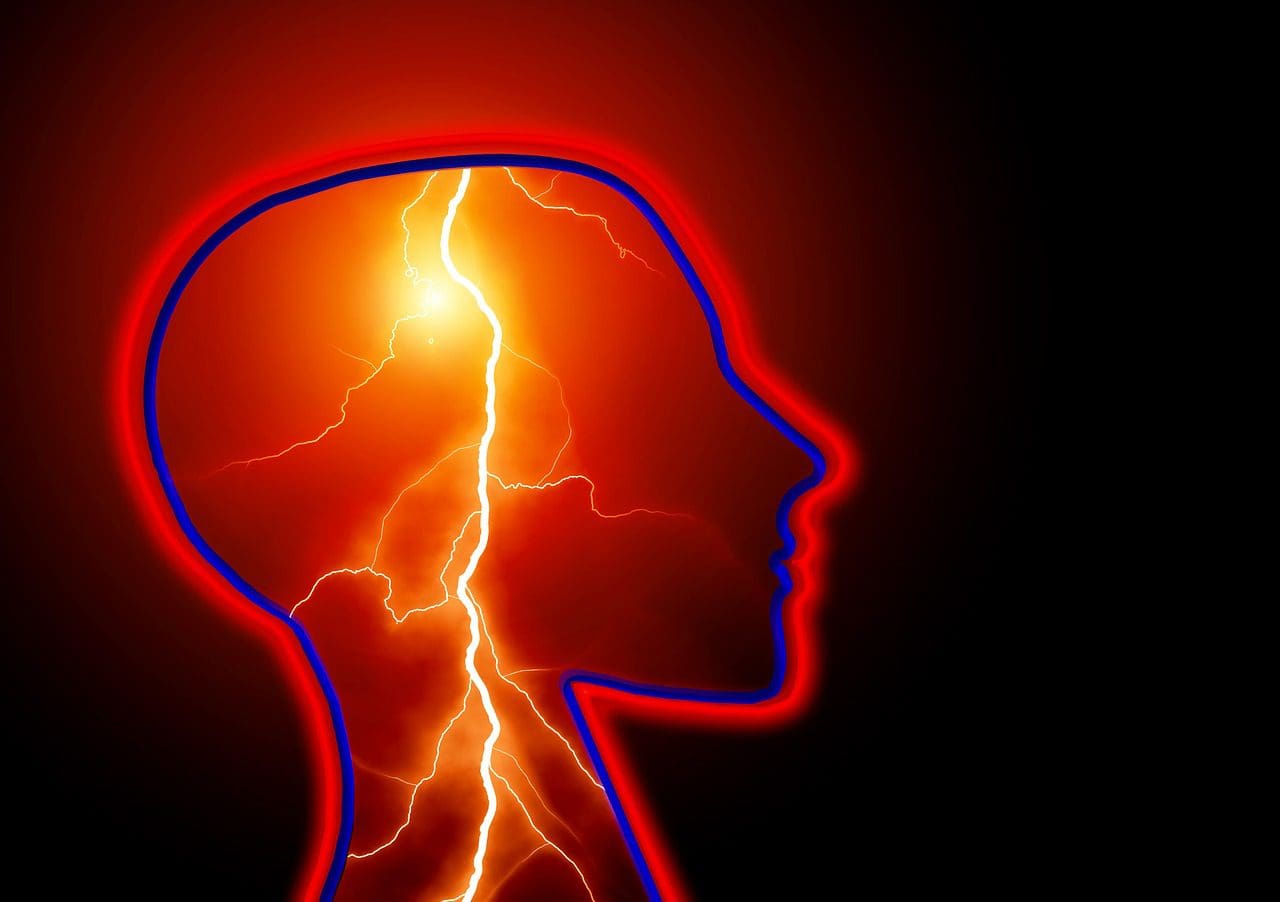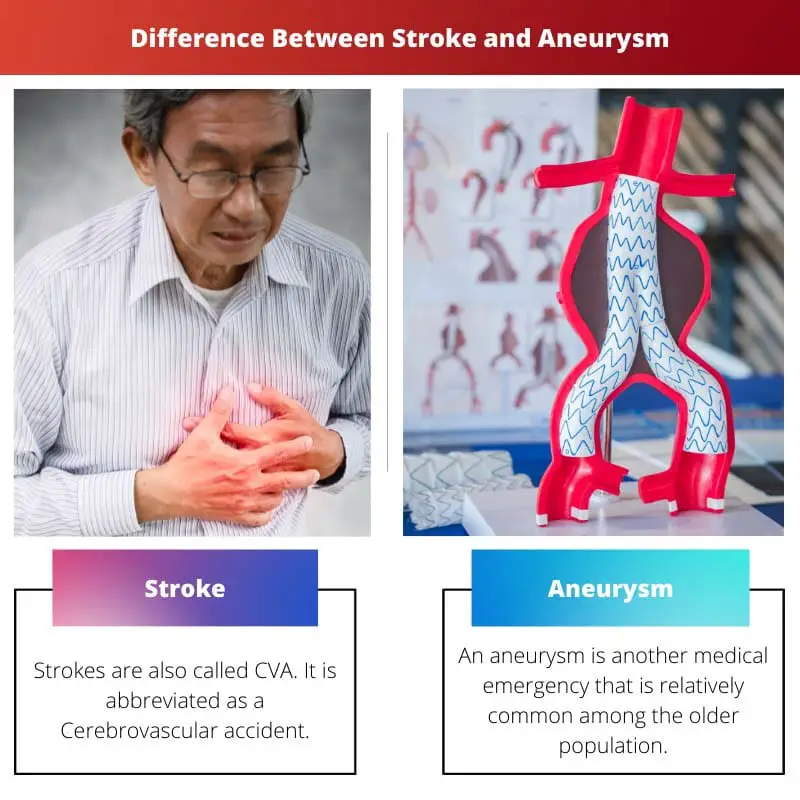Stroke and Aneurysm are life-threatening diseases that both require proper medical attention and care to avoid any kind of danger. Both affect the brain in certain different ways.
One is said to have a stroke if the blood supply to the brain is blocked or the blood vessel gets ruptured. On the other hand, an aneurysm occurs if an artery gets weakened.
Key Takeaways
- A stroke occurs when blood flow to the brain is disrupted, leading to brain cell damage or death, while an aneurysm is a weakened, bulging artery wall that may rupture.
- Strokes are divided into ischemic and hemorrhagic types, while aneurysms include thoracic and abdominal aortic types and cerebral aneurysms.
- Stroke symptoms involve sudden weakness, vision problems, and confusion, whereas aneurysm symptoms depend on the location and may be asymptomatic until rupture.
Stroke vs Aneurysm
The difference between a Stroke and an Aneurysm is that a stroke occurs when the blood supply to the brain gets blocked or the blood vessel presented in the brain gets ruptured, whereas an aneurysm is said to occur if the artery gets weakened or swelled. It may also lead to a stroke. If left untreated, it can lead to serious issues, including internal bleeding.

A stroke occurs when there is a lack of blood flow to the brain or the blood vessels in the brain get ruptured. There are different types of strokes, including ischemic stroke, hemorrhagic stroke, and transient ischemic attack.
Those are considered to be the main types of strokes. One may experience a weakened arm, trouble walking, headache, and so on. An aneurysm is said to occur if the artery wall is weakened or enlarged (swollen condition). A brain aneurysm can lead to a stroke.
The most common form of aneurysm is the brain aneurysm and heart aneurysm, which needs immediate medical attention. One may experience headaches, troubled eyesight, nausea, and neck pain.
Comparison Table
| Parameters of Comparison | Stroke | Aneurysm |
|---|---|---|
| Details | Blood supply to the brain is blocked, or blood vessel is ruptured. | The artery is weakened or swollen. |
| Symptoms | Weakness in the arm, dropping face, difficulty speaking, dizziness, headache. | Neck pain, headache, troubled eye-sight, dizziness, internal bleeding, and so on. |
| Treatment | Medication is sufficient for an ischemic stroke. | Medications can be used for cerebral aneurysms with a wait-and-watch method. |
| Causes | It occurs when an artery in the brain is blocked. | It occurs when an artery or arterial wall is damaged. |
| Diagnosis | CT and MRI scans can be used to diagnose. | Symptoms, personal medical history, along CT and MRI scans can be used to diagnose. |
What is Stroke?
Strokes are also called CVA. It is abbreviated as a Cerebrovascular accident. Strokes are a medical emergency that is quite common among the older population.
Even as a common case, strokes need to be treated with medical attention immediately after noticing the symptoms. The symptoms of stroke can be quite challenging and can dull the patient’s ability to nil.
To define it in clear medical terms, strokes tend to occur when there is a lack of blood flowing to the brain. It can also occur when the blood vessels situated inside the brain are ruptured.
So, when the blood supply is interrupted by a blockage, the brain tissue is prevented from receiving oxygen and nutrients. This act causes the brain cells to die within minutes.
The symptoms of a stroke can be quite evident and problematic. Dizziness in speech and struggle to put the words together is a clear symptom of a stroke attack.
Numbness in the areas of the face, arm, or leg is another symptom. Apart from these, severe headache is a symptom of stroke, too.
There are two types of strokes and they are ischemic stroke and hemorrhagic stroke. Ischemic stroke is the most common type of stroke. It occurs when the blood vessels are blocked. Hemorrhagic strokes can occur when a blood vessel in the brain leaks or is ruptured.

What is Aneurysm?
An aneurysm is another medical emergency that is relatively common among the older population. The aneurysm is also called aneurysmal dilation.
Cases of aneurysms are not as dangerous or life-threatening as strokes, but they can be dangerous if left to continuous bleeding. It is necessary to provide medical care as soon as possible.
An aneurysm can be defined in medical terms as the enlargement of an artery that is caused by a weakness in the arterial wall. A brain aneurysm is not too dangerous, but it allows a higher chance of leading to a stroke.
The weakness of the artery wall creates a bulge of the artery present within the brain. There are not any definite symptoms for aneurysms like strokes or any other medical emergency. The aneurysm can only be confirmed after the rupture of the arterial wall.
However, there are a few common symptoms, like dizziness, neck pain, and headache, that can be related to an aneurysm.
The risk of this disease depends on the size of the bulge of the arterial walls. Two common types of aneurysms are brain aneurysms and heart aneurysms. Cases of unruptured aneurysms do not always require active treatment.
However, a ruptured aneurysm case requires immediate medical attention to reduce the risks.

Main Differences Between Stroke and Aneurysm
- Strokes are caused when the blood vessel that supplies oxygen and nutrients to the brain or the blood vessels in the brain is blocked. An aneurysm occurs in cases where there is a weakened or swollen arterial wall.
- Symptoms of stroke include dizziness in speech and numbness of the arms, legs, and face. Aneurysm does not have clear symptoms, but headache and neck pain are some common symptoms.
- There are two types of strokes and they are ischemic and haemorrhage strokes. There are two types of aneurysms, and they are brain and heart aneurysms.
- Strokes are more dangerous and life-threatening and require immediate medical attention to maintain the chances of survival. Aneurysms without ruptured arterial walls are not as dangerous as strokes and can be treated with a wait-and-watch method.
- Strokes do not lead to an aneurysm. However, cases of aneurysms have higher chances of leading to strokes if not treated.


The article does a good job of explaining the symptoms associated with both stroke and aneurysm. It’s important to recognize these signs early for timely medical attention.
Absolutely. Knowing the symptoms can make a significant difference in patient outcomes. This article highlights the importance of symptom awareness.
I completely agree, Nathan. Early recognition of symptoms is crucial for preventing severe consequences.
The comparison between stroke and aneurysms was well-presented, providing a comprehensive understanding of each condition’s characteristics. Great work on this informative piece!
Absolutely, Bgreen. It’s essential to have accurate and accessible information about such critical health issues.
This article seems to emphasize the urgency of seeking medical attention for both stroke and aneurysm. It’s a sobering reminder of the importance of early detection and intervention.
This article provides a comprehensive overview of stroke and aneurysm, creating awareness and emphasizing the importance of understanding the symptoms and seeking timely medical attention.
This article provides a clear and concise explanation of the differences between stroke and aneurysm, as well as their symptoms and causes. It’s a great source of information for everyone to understand these life-threatening conditions and their implications.
I totally agree, Frank. This is a very informative article and can help raise awareness and understanding of these conditions.
I appreciate the detailed comparison table in this article. It makes it easier to understand the key differences between stroke and aneurysm. It’s great to have this information readily available.
Agreed. The article is very well-structured and provides valuable insights into the topic.
Definitely, the comparison table provides a clear overview of the characteristics of both conditions. Well-organized and helpful!
The article effectively underscores the critical nature of these conditions. It’s a timely reminder to prioritize health and seek prompt medical help when experiencing related symptoms.
Indeed, Dbutler. This article encourages vigilance and proactive healthcare-seeking behavior.
I agree. Being informed about these conditions is essential for taking appropriate action to safeguard one’s health.
I found this article to be a little bit frightening. The severity of these conditions is quite daunting, and while knowledge is power, it’s scary to think about the potential risks.
I understand where you’re coming from, Hollie. It’s important to be informed, but it can be overwhelming to think about the potential dangers.